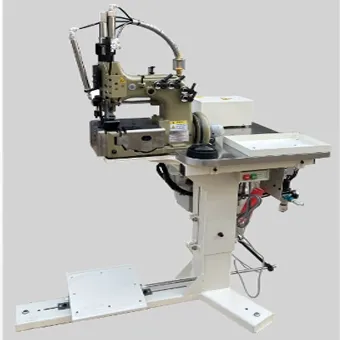Exploring the Versatility and Innovation of Modern Chain Stitch Sewing Machines for Creative Projects
The Modern Chain Stitch Machine Revolutionizing Textile Production
In the landscape of textile production, the evolution of sewing technology has had a profound impact on efficiency, creativity, and quality. Among the myriad of sewing machines available today, the modern chain stitch machine stands out as a key player. This innovative machine not only enhances the speed of production but also elevates the quality of finishing in garment manufacturing, making it an indispensable tool in the fashion and textile industries.
At its core, the chain stitch machine operates on a unique mechanism that utilizes a single-thread system to create a flexible and durable stitch. Unlike conventional lockstitch machines, which utilize two threads, the chain stitch method allows for a variety of applications, from delicate fabric to heavy materials. The machine’s ability to produce a chain-like stitch makes it particularly advantageous for creating seams that require stretch and durability, such as in athletic wear and denim.
The versatility of the modern chain stitch machine is evident in its applications across various sectors. In the garment industry, it is widely used for sewing stretch fabrics and intricate designs, allowing for more intricate patterns without sacrificing quality. Moreover, the machine can be customized with different needle sizes and thread types, further expanding its range of capabilities. This adaptability not only meets the demands of contemporary fashion but also supports innovative design techniques, pushing the boundaries of creative expression in textile production.
One of the most significant benefits of the modern chain stitch machine is its efficiency in production processes. With advancements in technology, many of these machines are now equipped with automated features that enhance speed and precision. For instance, computerized models offer programmable stitch patterns and adjustable settings that streamline the sewing process. This technological integration reduces labor costs and minimizes errors, ultimately leading to higher productivity levels. Manufacturers can meet tight deadlines without compromising quality, giving them a competitive edge in a fast-paced market.
modern chain stitch machine

Moreover, the machine’s design encourages easy maintenance and repair, which is vital for continuous operation in busy factories. The simplicity of its components allows for quick troubleshooting and replacement, minimizing downtime. As businesses seek to optimize their production lines, the reliability of the modern chain stitch machine plays a crucial role in sustaining operations and maximizing output.
Sustainability is another important aspect of the modern chain stitch machine. By enabling fast production with minimal waste, manufacturers can align with eco-friendly practices that are becoming increasingly important in today’s market. Efficient use of materials and the ability to quickly adapt to changing consumer demands allows companies to reduce their environmental footprint while still delivering high-quality products.
The modern chain stitch machine also fosters skill development among workers. As these machines often require specialized knowledge and techniques, they encourage training programs that enhance the capabilities of the workforce. This investment in human capital not only improves production outcomes but also contributes to job satisfaction and retention within the industry.
In conclusion, the modern chain stitch machine represents a significant advancement in textile production, combining innovation, speed, and sustainability. Its versatility, efficiency, and adaptability make it an essential tool for manufacturers looking to thrive in a competitive market. As the fashion industry continues to evolve, embracing new technologies and methodologies, the chain stitch machine will undoubtedly play a pivotal role in shaping the future of garment production. By enhancing creativity and operational efficiency, it propels the industry forward, ensuring that textile production keeps pace with the ever-changing demands of consumers and designers alike.
-
Leather Sewing Machine: The Industrial Standard for Tough MaterialsNewsJul.18,2025
-
Sail Making Machine: Heavy-Duty Stitching for Industrial and Marine NeedsNewsJul.18,2025
-
Sling Sewing Machine: The Backbone of Heavy-Duty FabricationNewsJul.18,2025
-
Leather Sewing Machine: Precision for Heavy-Duty StitchingNewsJul.18,2025
-
Big Bag Sewing Machine: Powering the Future of Bulk PackagingNewsJul.18,2025
-
FIBC Sewing Machine: Essential Equipment for Bulk Bag ProductionNewsJul.18,2025
-
Heavy Duty Leather Sewing Machine: A Must-Have for Professional LeatherworkNewsMay.28,2025





























